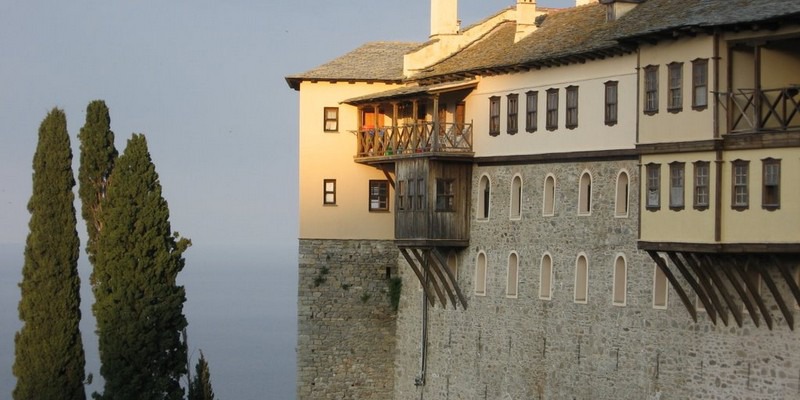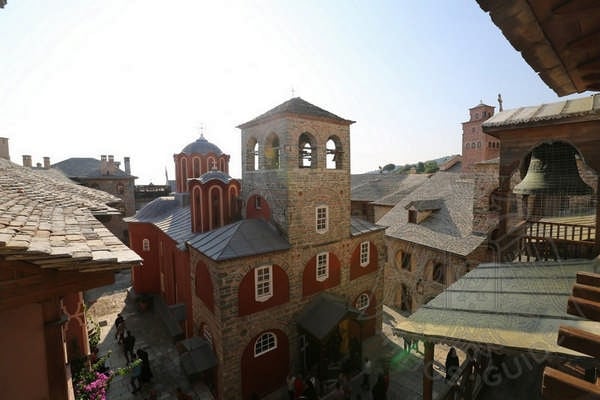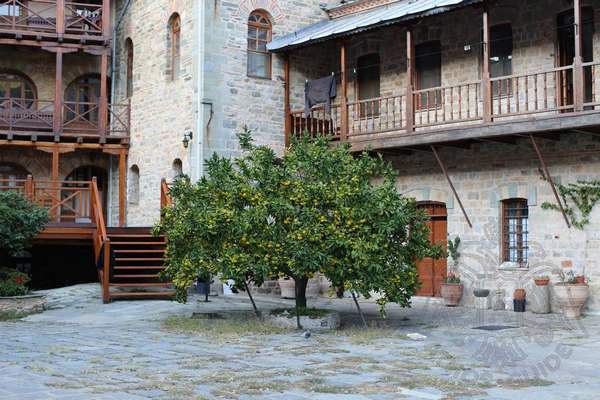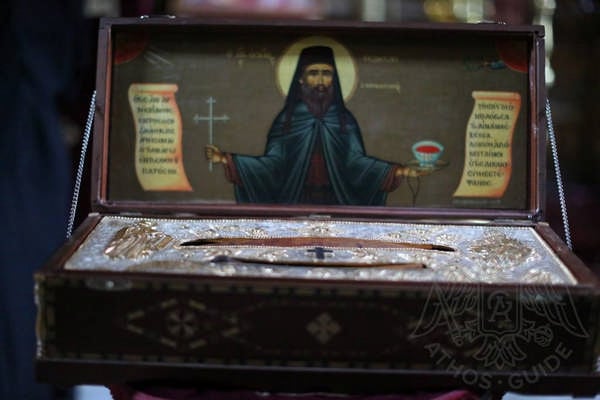History and present days
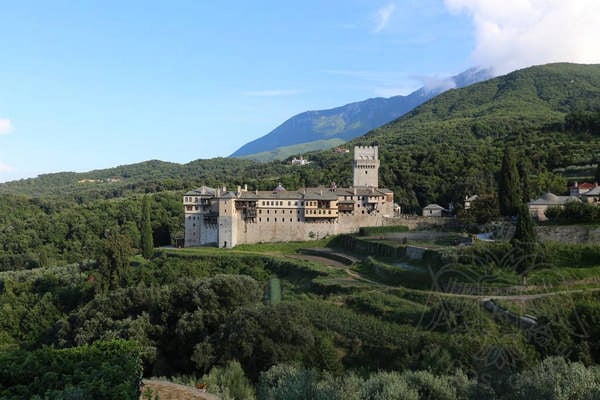
The Monastery of Karakallou is built in a prominent location, surrounded by streams and lush green vegetation, at an altitude of 200 meters above sea level. It is small in size, with a distinct fortification character. Its ground plan forms a quadrilateral. On the west side, the defensive tower dominates. The balconies and the carved wooden details, with their elegance and color, create a beautiful impression to the northern part, while the southern part, in contrast, conveys a sense of severity. Beyond the tower, there can be seen the colorful domes of the Cell of the Holy Cross. Further to the right on the slope there is the Cell of the Three Hierarchs that belongs to the Karakallou Monastery. The cell on the slope east of the monastery is a dependency of the Monastery of Great Lavra.
History
The monastery is dedicated to the Holy Apostles Peter and Paul. This was its original name, which was later replaced by the name "Karakallou," leading to various etymologies and interpretations. According to one tradition, its founder was the Roman Emperor Caracalla, a pagan and persecutor of Christians, who is depicted in a popular fresco on the north wall of the cemetery's exonarthex. Some scholars believe that only the seaside tower dates back to the Roman emperor, while others derive the name from “Karyai Kalae” (Good Karyes) referring to the rich forest of hazelnut trees surrounding the monastery, or from the Turkish "kara-kule" (black tower). More likely, the name originates from a farmer named Nikolaos, a member of the Byzantine Karakalla family from Dimitsana.
A document from the First Typikon (1018) defines the boundaries of the Monasteries of Karakallou and Amalfinou, proving the monastery's existence at that time. In Monomachos' Typikon (1046), there is no mention of the monastery, but a document from the First Typikon (1087) refers to its abbot, Michael. In the 13th century, the monastery suffered destruction from pirate raids and Latin occupations. In 1294, Emperor Andronikos II Palaiologos issued a golden bull granting privileges and securing the monastery's possessions to aid in its reconstruction. Isaac I and Patriarch Athanasius showed particular interest in its restoration.
Following its reconstruction, the monastery flourished and its monastic population grew. To meet its needs, the monastery acquired metochia in Thessaloniki, the Struma valley, and Lemnos. In 1324, a document signed by the Protos granted the monastery the small Cell of Exypolytus to ensure an uninterrupted water supply.
However, prosperity was followed by new destructions by pirates. In 1548, Sultan Suleiman the Magnificent issued a firman allowing the rebuilding of the church. The reconstruction was supported by the rulers of Wallachia, Peter V Rares (1527–38) and his son-in-law Alexander IV Depusnianos (1557–62), who became a monk shortly before his death, taking the name Pachomius. His wife, Roxandra, generously supported the athonite monasteries. In the 17th century, the ruler of Iberia (Georgia), Arthil, and his brother Vakhtang provided financial aid. The monastery reached its greatest prosperity in the 18th century, and in 1813, was restored to the cenobitic system by a patriarchal decree of Cyril VI. However, it soon suffered great devastation, when Ottoman troops occupied Mount Athos after the 1821 Revolution in Chalkidiki. In 1875, the south and east wings were destroyed by fire. During the second half of the 19th century, many Russians settled in nearby cells (Holy Cross) with the intention of transforming them into cenobitic sketes and eventually integrate them to the monastery. Their plans, however, did not succeed. In 1988, a lightning-induced fire destroyed the top three floors of the monastery's northern corner. The wing was subsequently restored by the authorities responsible for the athonite legacy.
In the Monastery of Karakallou, the Holy New Martyr Gideon lived for 35 years. Born near Velestino, he was forcibly converted to Islam, later repented, became a monk and then a martyr in 1818 in Tyrnavos, Thessaly, where he is honored as the patron saint. Another saint associated with the monastery was Saint Gervasios the Athonite and Fool-for-Christ (commemorated on October 11), who came from the village of Gomati in Chalkidiki. His sanctity was realized only after his passing in 1830, when his holy relic emitted a miraculous fragrance.
The Seaside Tower
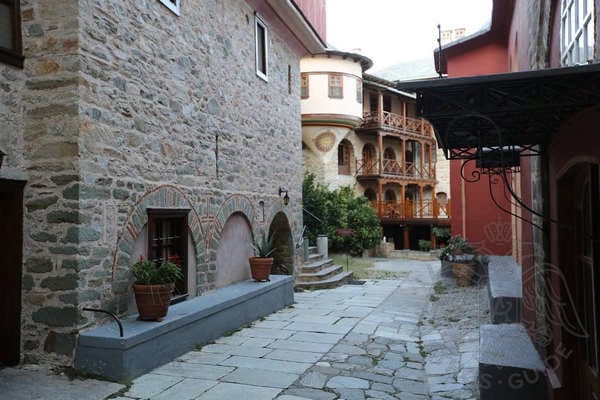
At the opening of the ravine that crosses the road to the sea, there is a small elegant stone bridge. A little further on, we find the seaside tower of the Monastery of Karakallou, arguably the most beautiful tower in Mount Athos. It is built next to the monastery's current arsanas, on a rock at a height of 15 meters above the sea.
It is an independent structure, standing 21.60 meters high, with dimensions at its square base of 7.25 x 7.30 meters. It is built with large rough stones and strong mortar, incorporating pieces of marble. The structure features battlements. Unfortunately, nothing remains of the interior. The structure is probably of late Byzantine origin.
The fortified bastion was added in 1534 at the expense of the Wallachian ruler Peter V Rares (1527-1538). On the western facade of the porch, there is a cross-shaped ceramic-plaster decoration. Below the porch there is the entrance to the area of the bastion. A marble inscription on the wall informs us that during the reign of Germain, “John Peter the voivode/Joasaph the monk founder/Syropoulos Dionysios X [Hatzis] and/the first master until 1534, the tower and the bastion were completed”. This is a rare case where the name of the craftsman has been preserved on a building in Mount Athos. Architectural traces indicate that the interior of the bastion was once covered by a roof and included hospitality areas, a chapel, and a trapeza. According to tradition, Peter the voivode sent a man with a substantial amount of money to renovate the Monastery of Karakallou. However, the man built only the bastion and then left with the remaining funds. When Peter the voivode realised what happened, he got furious. To save his life, the man promised to renovate the monastery at his own expense. Peter forgave him and traveled to Mount Athos, where they both became monks, taking the name Pachomios.
